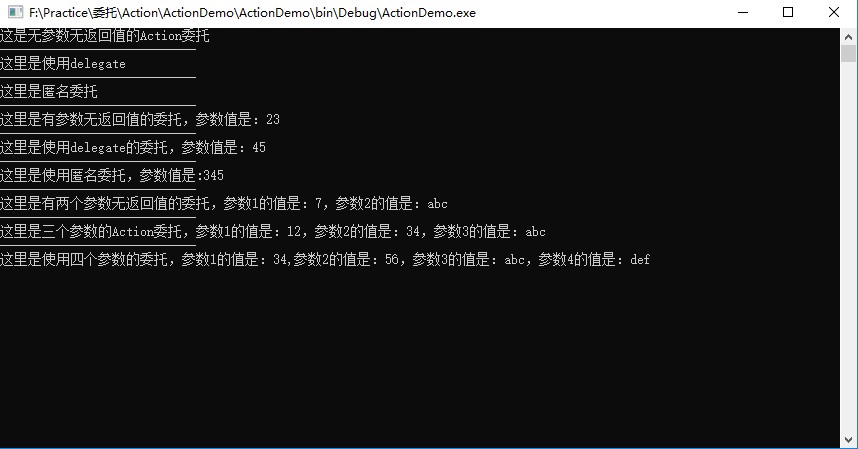C# Action委托
.NET开发菜鸟 人气:41、什么是Action泛型委托
Action<T>是.NET Framework内置的泛型委托,可以使用Action<T>委托以参数形式传递方法,而不用显示声明自定义的委托。封装的方法必须与此委托定义的方法签名相对应。也就是说,封装的方法必须具有一个通过值传递给它的参数,并且不能有返回值。
2、Action委托定义
查看Action的定义:
using System.Runtime.CompilerServices;
namespace System
{
//
// 摘要:
// 封装一个方法,该方法不具有参数且不返回值。
[TypeForwardedFrom("System.Core, Version=3.5.0.0, Culture=Neutral, PublicKeyToken=b77a5c561934e089")]
public delegate void Action();
}你会发现,Action其实就是没有返回值的delegate。
3、示例
Action委托至少0个参数,至多16个参数,无返回值。
Action 表示无参,无返回值的委托。
Action<int,string> 表示有传入参数int,string无返回值的委托。
Action<int,string,bool> 表示有传入参数int,string,bool无返回值的委托。
Action<int,int,int,int> 表示有传入4个int型参数,无返回值的委托。

代码示例如下:
using System;
using System.Collections.Generic;
using System.Linq;
using System.Text;
using System.Threading.Tasks;
namespace ActionDemo
{
class Program
{
static void Main(string[] args)
{
// 无参数无返回值的委托
Action action1 = new Action(ActionWithNoParaNoReturn);
action1();
Console.WriteLine("----------------------------");
// 使用delegate
Action action2 = delegate { Console.WriteLine("这里是使用delegate"); };
// 执行
action2();
Console.WriteLine("----------------------------");
// 使用匿名委托
Action action3 = () => { Console.WriteLine("这里是匿名委托"); };
action3();
Console.WriteLine("----------------------------");
// 有参数无返回值的委托
Action<int> action4 = new Action<int>(ActionWithPara);
action4(23);
Console.WriteLine("----------------------------");
// 使用delegate
Action<int> action5 = delegate (int i) { Console.WriteLine($"这里是使用delegate的委托,参数值是:{i}"); };
action5(45);
Console.WriteLine("----------------------------");
// 使用匿名委托
Action<string> action6 = (string s) => { Console.WriteLine($"这里是使用匿名委托,参数值是:{s}"); };
action6("345");
Console.WriteLine("----------------------------");
// 多个参数无返回值的委托
Action<int, string> action7 = new Action<int, string>(ActionWithMulitPara);
action7(7, "abc");
Console.WriteLine("----------------------------");
// 使用delegate
Action<int, int, string> action8 = delegate (int i1, int i2, string s)
{
Console.WriteLine($"这里是三个参数的Action委托,参数1的值是:{i1},参数2的值是:{i2},参数3的值是:{s}");
};
action8(12, 34, "abc");
Console.WriteLine("----------------------------");
Action<int,int,string, string> action9 = (int i1,int i2, string s1,string s2) =>
{
Console.WriteLine($"这里是使用四个参数的委托,参数1的值是:{i1},参数2的值是:{i2},参数3的值是:{s1},参数4的值是:{s2}");
};
// 执行委托
action9(34,56, "abc","def");
Console.ReadKey();
}
static void ActionWithNoParaNoReturn()
{
Console.WriteLine("这是无参数无返回值的Action委托");
}
static void ActionWithPara(int i)
{
Console.WriteLine($"这里是有参数无返回值的委托,参数值是:{i}");
}
static void ActionWithMulitPara(int i,string s)
{
Console.WriteLine($"这里是有两个参数无返回值的委托,参数1的值是:{i},参数2的值是:{s}");
}
}
}运行结果:

4、真实示例
先看下面一张截图:

从截图中可以看出:ForEach()方法的参数是一个参数类型是T的无返回值的Action委托,下面的示例中利用Action委托作为参数传递给ForEach()方法。
1、定义Student实体类
using System;
using System.Collections.Generic;
using System.Linq;
using System.Text;
using System.Threading.Tasks;
namespace ActionDemo
{
public class Student
{
public int Id { get; set; }
public string Name { get; set; }
public int Age { get; set; }
public int Sex { get; set; }
}
}2、利用ForEach()方法输出集合内容
using System;
using System.Collections.Generic;
using System.Linq;
using System.Text;
using System.Threading.Tasks;
namespace ActionDemo
{
public class ActionTest
{
public static void Test()
{
List<Student> list = new List<Student>()
{
new Student(){Id=1,Name="张三",Age=19,Sex=1},
new Student(){Id=2,Name="李四",Age=20,Sex=2},
new Student(){Id=3,Name="王五",Age=23,Sex=1},
new Student(){Id=4,Name="赵六",Age=18,Sex=1}
};
// Action<Student>委托作为参数传递给ForEach()方法
list.ForEach(student =>
{
Console.WriteLine($"姓名:{student.Name},年龄:{student.Age}");
});
}
}
}3、在Main()方法中调用
ActionTest.Test();
4、结果

到此这篇关于C#内置泛型委托之Action委托的文章就介绍到这了。希望对大家的学习有所帮助,也希望大家多多支持。
加载全部内容